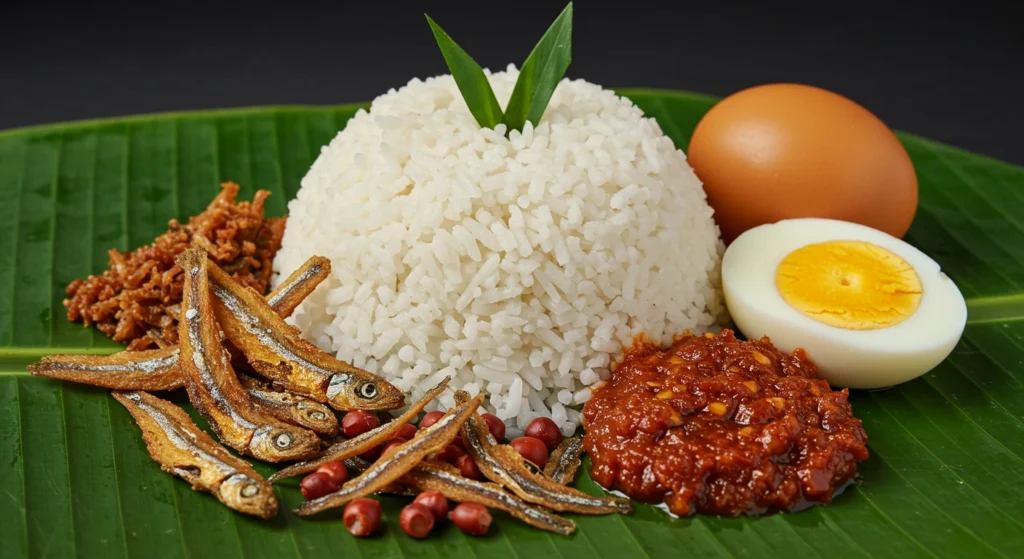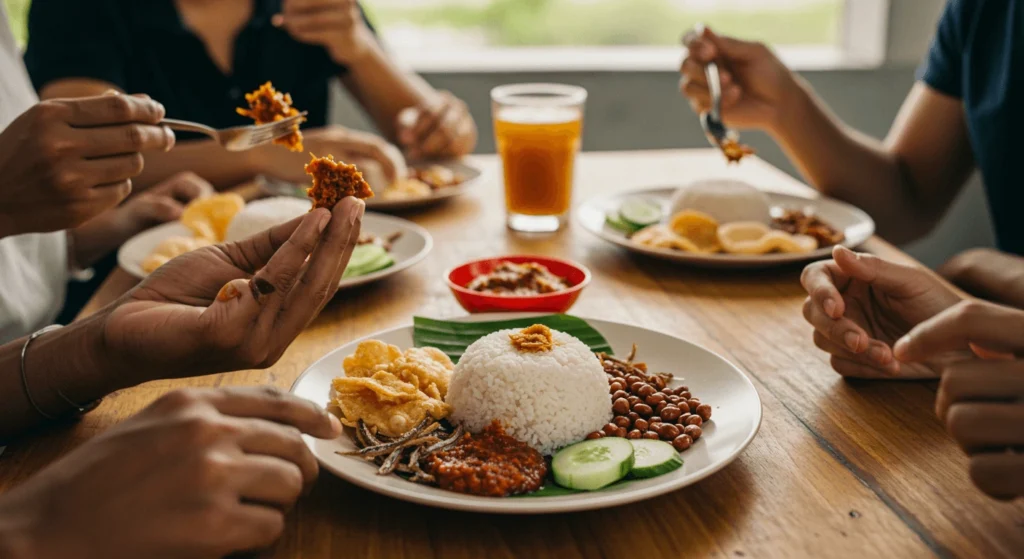Introduction
Nasi lemak is not just a dish; it’s a cherished part of Malaysian culture and history. Its fragrant coconut rice, spicy sambal, and delicious sides make it a favorite among locals and visitors. Malaysians enjoy it everywhere, from street food stalls to upscale restaurants. This iconic dish has become a unifying comfort food for the nation.
In this blog post, we’ll explore how nasi lemak grew from humble beginnings to Malaysia’s most beloved meal. You’ll learn about its history, key ingredients, and cultural significance. We’ll also reveal the best places to try nasi lemak in Malaysia and share tips for making it at home. Whether you’re a foodie or curious traveler, you’ll leave with a deeper appreciation for this timeless classic.
The Humble Beginnings of a Malaysian Icon

From fields to kitchens: The dish’s historical roots in Malay culture
Nasi lemak has humble beginnings as a practical meal for farmers in rural Malaysia. Early Malays relied on this dish for its simplicity, nutrition, and convenience. Coconut milk, abundant in tropical Malaysia, was used to enhance the rice’s flavor and keep it moist. Farmers paired the rice with sambal, made from readily available chilies and anchovies, creating a meal that could sustain them through long workdays.
Wrapped in banana leaves, this specialty became portable and easy to store, perfect for farmers traveling to distant fields. The meal’s components—rice for energy, sambal for flavor, and protein-rich sides like boiled eggs or anchovies—offered a balanced meal. These practical origins laid the foundation for this dish’s enduring popularity.
Evolution of Nasi Lemak Over Time
From its start as a farmer’s staple, this delicacy has transformed into a versatile and beloved Malaysian dish. Over time, it moved from rural villages to urban areas, gaining popularity across different communities. By the mid-20th century, this specialty was no longer just a breakfast item but a comfort food enjoyed throughout the day.
Today, this recipe is available everywhere—from roadside stalls to high-end restaurants. Vendors began adding variations, such as fried chicken, beef rendang, or sambal squid, elevating its appeal. Modern interpretations, like nasi lemak burgers and sushi, have also emerged, demonstrating its adaptability while maintaining its traditional essence.
Regional Influences on the Classic Nasi Lemak Recipe
Malaysia’s rich cultural diversity has contributed to the evolution of this meal. Each region has its own spin on the dish. For instance, in the southern state of Johor, this delicacy is often served with sambal sotong (spicy squid). In Penang, the dish may include a sweeter sambal, reflecting the region’s Chinese influence.
Neighboring countries have also shaped this specialty. In Indonesia, a similar dish called nasi uduk uses coconut rice paired with fried chicken and tempeh. Singapore offers its own versions, with hawker stalls serving this meal alongside unique sides like otak-otak (grilled fish cake).
These regional and international variations enrich this dish’s legacy, making it not only a Malaysian favorite but also a dish appreciated across Southeast Asia.
Key Ingredients That Define Authentic Nasi Lemak

The Role of Coconut Milk in Nasi Lemak’s Signature Flavor
Coconut milk, or santan, creates the creamy, fragrant quality that defines this dish. Chefs combine coconut milk, water, pandan leaves, and a pinch of salt to cook the rice, resulting in its rich, aromatic flavor. Fresh coconut milk enhances the recipe’s authenticity because it delivers a natural creaminess. Additionally, pandan leaves, tied in a knot and added during cooking, contribute their unique fragrance to the rice.
Traditionally, cooks steam the rice rather than boiling it. This method ensures that every grain absorbs the coconut milk evenly, producing fluffy, flavorful rice. Without coconut milk, the meal would lose its unique identity and become a plain rice dish.
For example, a street vendor in Kuala Lumpur might use locally sourced fresh coconut milk to ensure a rich taste. At the same time, urban cafes often innovate by infusing the rice with additional herbs like lemongrass, enhancing its traditional flavor. Therefore, coconut milk remains essential for achieving authentic results.
Sambal: The Spicy Heart of Nasi Lemak
Sambal forms the flavorful core of this specialty, adding heat and tanginess to the dish. Made with red chilies, onions, garlic, shrimp paste, and tamarind juice, sambal creates a bold contrast to the creamy rice. Additionally, each region personalizes its sambal. For instance, Penang favors a sweeter version, while Johor emphasizes heat with intense shrimp paste flavors.
The tamarind juice provides a tangy kick that balances the sambal’s spiciness, making it a perfect complement to the other components. For example, in some versions, the sambal includes caramelized onions for a sweeter finish.
Chefs often say, “The sambal makes or breaks the dish.” Its balance of flavors determines whether the recipe succeeds. As a result, mastering sambal preparation is critical for delivering an exceptional experience.
Traditional Accompaniments: Anchovies, Peanuts, and More
The traditional accompaniments in this dish create a harmonious balance of textures and flavors. Crispy fried anchovies, or ikan bilis, add a salty crunch that complements the creamy rice. Additionally, toasted peanuts provide a nutty flavor, while boiled eggs offer a neutral component to balance the sambal’s heat.
Vendors often serve sliced cucumbers alongside the dish, providing a refreshing contrast to the rich flavors. For example, in upscale restaurants, chefs sometimes use pickled cucumbers for an elevated twist. Meanwhile, street vendors might enhance the recipe with additional options like sambal squid, fried chicken, or beef rendang, adding indulgent flavors.
Every component contributes to the specialty’s appeal. Therefore, the balance between these sides transforms this dish from a simple meal into a comforting, satisfying experience.
Why Nasi Lemak is a Beloved Comfort Food in Malaysia

Nasi Lemak as a Breakfast Staple Across the Country
This dish has become a quintessential breakfast choice in Malaysia, found in nearly every morning market. Its affordability, portability, and satisfying flavors make it a favorite among busy Malaysians. Vendors often wrap this specialty in banana leaves, creating a convenient grab-and-go meal for commuters.
For example, in Kuala Lumpur’s bustling streets, vendors start selling the meal before dawn to cater to early risers. Each packet, priced as low as RM1.50, offers a complete meal. The fragrant coconut rice, paired with spicy sambal and crispy anchovies, provides energy for the day ahead.
Additionally, its availability extends beyond urban areas. Small towns and villages also feature this dish at morning stalls, where locals gather for a hearty breakfast. This widespread accessibility solidifies its role as a beloved morning staple across Malaysia.
A Dish for All Occasions: From Street Food to Fine Dining
Nasi lemak’s adaptability has elevated it from humble street food to a dish celebrated in high-end restaurants. At roadside stalls, it is often served in its simplest form—coconut rice, sambal, anchovies, and a boiled egg. Despite its simplicity, its bold flavors make it irresistible.
In upscale settings, chefs have reimagined nasi lemak to cater to gourmet tastes. For instance, restaurants like Bijan in Kuala Lumpur present it with premium accompaniments such as lobster sambal or wagyu beef rendang. These innovative takes showcase its versatility while retaining its core identity.
Furthermore, nasi lemak appears in modern fusion creations. For example, trendy cafes serve nasi lemak burgers, sushi rolls, or even pizzas, blending traditional flavors with contemporary concepts. This adaptability ensures that nasi lemak remains relevant across generations and dining preferences.
Emotional and Cultural Connections Malaysians Have with Nasi Lemak
Nasi lemak represents more than food; it is a cultural icon that unites Malaysians from diverse backgrounds. Shared across ethnicities, it bridges gaps between Malay, Chinese, and Indian communities. This inclusivity reinforces its status as Malaysia’s national dish.
For example, families often bond over a table of nasi lemak during festive gatherings or weekend breakfasts. Additionally, food bloggers and chefs frequently share stories of nostalgia tied to their first bites of nasi lemak, emphasizing its emotional connection.
Moreover, the dish symbolizes Malaysian resilience and creativity. Despite its simple ingredients, nasi lemak delivers a complex flavor profile, reflecting Malaysia’s rich cultural tapestry. As a result, it resonates deeply with the nation’s identity and pride.
Where to Find the Best Nasi Lemak in Malaysia

Famous Nasi Lemak Street Food Stalls in Kuala Lumpur
Kuala Lumpur, Malaysia’s vibrant capital, is home to some of the country’s most iconic nasi lemak vendors. Among these, Nasi Lemak Antarabangsa stands out as a household name. Located in Kampung Baru, this stall has served generations of Malaysians, earning a reputation for its flavorful sambal and perfectly cooked rice.
Another favorite is Village Park Restaurant in Damansara Uptown. Known for its fried chicken nasi lemak, this spot attracts locals and tourists alike. The crispy, golden-brown chicken pairs wonderfully with the rich sambal and fragrant rice, making it a must-try for visitors.
For those seeking a late-night fix, Nasi Lemak Bumbung in Petaling Jaya is a popular choice. This roadside stall serves hearty portions of nasi lemak under the stars, offering an authentic street food experience. These iconic spots highlight why Kuala Lumpur remains the ultimate destination for nasi lemak lovers.
Exploring Regional Variations Across Malaysia
Nasi lemak’s popularity extends far beyond Kuala Lumpur, with each region adding its unique spin to the dish. In Penang, the sambal tends to be sweeter, reflecting the island’s Chinese culinary influences. Vendors in Penang often serve nasi lemak with pickled vegetables, adding a refreshing twist.
In Johor, the dish features a spicier sambal with strong shrimp paste flavors. Additionally, Johor’s version sometimes includes sambal sotong (spicy squid), enhancing its richness. The southern state’s proximity to the sea ensures the freshest seafood accompaniments.
Over in Sabah, nasi lemak incorporates native ingredients, such as tuhau (wild ginger) or hinava (raw fish salad). These additions create a uniquely Sabah-style nasi lemak that reflects the region’s indigenous flavors. Exploring these regional variations offers a deeper appreciation for the dish’s versatility.
Must-Try Modern Twists on Nasi Lemak in Trendy Cafes
Modern cafes across Malaysia have embraced nasi lemak, giving it creative twists that attract a younger audience. One standout creation is the nasi lemak burger, featuring coconut rice patties, sambal sauce, and crispy chicken or beef. This innovative dish is a hit at cafes like myBurgerLab in Kuala Lumpur.
Another popular reinvention is the nasi lemak sushi roll, blending Japanese and Malaysian flavors. Cafes like Ruyi & Lyn serve these rolls with sambal dipping sauce, creating a fusion experience. For dessert lovers, nasi lemak cheesecake, made with coconut-infused layers and sambal caramel, offers a surprising yet delightful twist.
These modern adaptations maintain the essence of nasi lemak while showcasing its ability to evolve with culinary trends. Therefore, trendy cafes provide a fresh way to enjoy this beloved dish.
Tips for Making the Perfect Nasi Lemak at Home

Choosing the Right Ingredients for Authentic Nasi Lemak
Authentic nasi lemak begins with selecting high-quality, fresh ingredients. Start by sourcing pandan leaves, which are crucial for fragrance. Fresh pandan leaves are available in Asian grocery stores and should be vibrant green and pliable. These leaves infuse the rice with an aromatic, sweet scent that defines nasi lemak.
For the sambal, use dried chilies that are deep red and pliable, as they yield a rich, vibrant paste. Combine them with fresh shallots, garlic, shrimp paste, and tamarind pulp for an authentic flavor. Avoid pre-packaged sambal, as it often lacks the depth of homemade versions.
Additionally, choose fresh coconut milk for the rice. While canned coconut milk works in a pinch, fresh coconut milk delivers superior creaminess and aroma. High-quality anchovies, preferably from Malaysia or Indonesia, ensure the best taste for your crispy toppings. Using these authentic ingredients guarantees a delicious nasi lemak.
Cooking Techniques for Fragrant Coconut Rice
Cooking fragrant coconut rice requires attention to detail. Begin by rinsing the rice thoroughly to remove excess starch. Add the rice to a pot with water, fresh coconut milk, and a pinch of salt. Include pandan leaves tied into a knot, which enhances the rice’s aroma.
Use a ratio of one part coconut milk to two parts water for perfect consistency. Bring the mixture to a boil, then reduce the heat to low and cover the pot. Allow the rice to steam gently until fully cooked, avoiding excessive stirring.
For even fluffier results, let the cooked rice rest for 10 minutes before fluffing it with a fork. Steaming the rice in a rice cooker or bamboo steamer can also yield excellent results. With these techniques, your coconut rice will be fragrant, creamy, and the perfect base for nasi lemak.
Creative Ways to Customize Your Nasi Lemak
Customizing nasi lemak allows you to create exciting variations that suit different tastes. One popular addition is fried chicken, which adds a crispy, savory element to the dish. For seafood lovers, sambal squid or prawns provide a rich, spicy twist.
Vegetarians can enjoy nasi lemak by substituting anchovies with crispy tofu or tempeh. Adding pickled vegetables, such as acar (spicy pickled cucumbers), introduces a tangy balance to the dish. Some modern variations include grilled salmon or roasted vegetables for a healthier take.
For a gourmet touch, try wrapping your nasi lemak in banana leaves and steaming it before serving. This method enhances the aroma and presentation. Experimenting with these toppings and techniques ensures your homemade nasi lemak is both authentic and personalized.
Conclusion: Why Nasi Lemak Deserves Its Place as Malaysia’s Comfort Food
Nasi lemak is more than just a meal—it is a symbol of Malaysia’s rich cultural heritage and culinary expertise. Its origins as a humble farmer’s breakfast reflect the nation’s resourcefulness, while its transformation into a versatile dish showcases Malaysia’s innovative spirit. Whether served at a roadside stall or a fine dining restaurant, nasi lemak consistently delivers the comforting flavors Malaysians love.
The dish’s fragrant coconut rice, bold sambal, and array of accompaniments create a harmonious balance of flavors. These elements make it a universally appealing meal that satisfies locals and visitors alike. Its adaptability, from classic recipes to modern twists like nasi lemak burgers, ensures its enduring popularity.
When visiting Malaysia, experiencing nasi lemak is essential. Head to Nasi Lemak Antarabangsa in Kuala Lumpur or explore the regional variations in Johor and Penang. If you’re inspired to recreate it at home, remember to source authentic ingredients like pandan leaves and fresh coconut milk for the best results.
In addition to nasi lemak, Malaysia boasts other iconic dishes that highlight its vibrant food culture. For instance, rendang, a slow-cooked meat dish, is packed with aromatic spices and rich coconut flavors. Another must-try is laksa, a spicy noodle soup with variations like Penang’s tangy asam laksa or the creamy curry laksa found in Kuala Lumpur.
Exploring these dishes alongside nasi lemak provides a deeper appreciation of Malaysia’s culinary diversity. Each dish tells a story, showcasing the nation’s history, creativity, and love for bold flavors. Whether dining in Malaysia or trying your hand at cooking, these meals promise a truly unforgettable experience.

